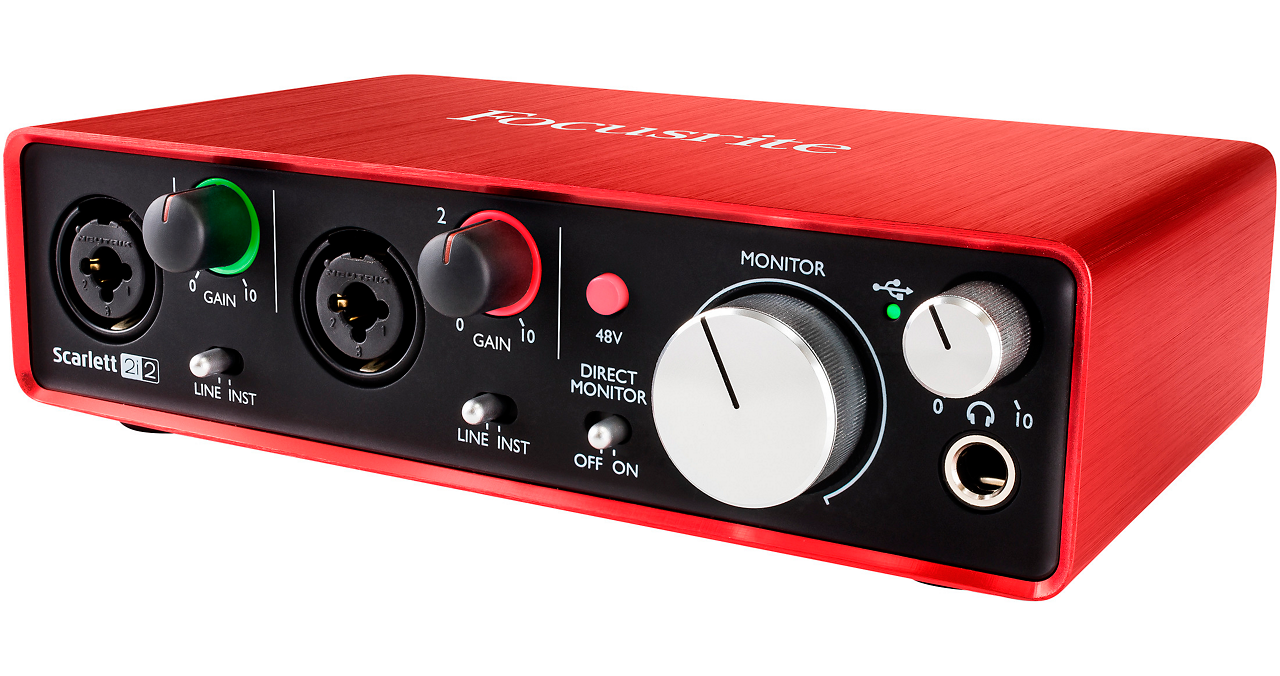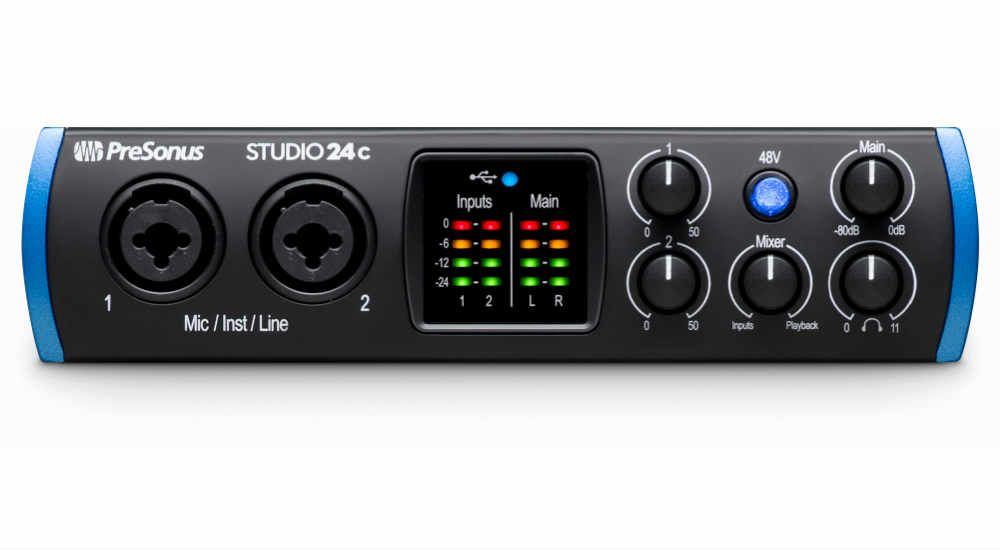For a bit of change of pace, I'm working out a few thoughts as to the next step I want to take with the music hobby. While it's not really new for me, heck, the whole extended family is musically inclined, taking it seriously and learning to play an instrument is knocking some serious rust off, and bothering to learn the theory is actually new.
That means "amp or computer inputs".
Well, the crappy amp I have is good enough to flatten the sound on it and use it as a straight speaker-out for the FX pedal I've got if I want to take it on vacation and play with family. And that's only if I have to - headphones work just fine, my dads house still has a bunch of extra amps from my brother, and both of my cousins have dedicate music rooms with MIDI, keyboards, drumsets, guitars, and multiple amps.
That means I'm turning to "computer interface/studio monitors", which in addition to clean sound has the added advantage of allowing me to record and play with composition and multiple parts, as well as giving me a preamp I can take on the road to mix signal/adjust gain/work with whatever is available. Small monitors will immensely improve the sound on my computer over the crappy $20 speakers I have, and I can choose a set I can take with me in a pinch by simply having a spare set of cables - though honestly there again I'll just as likely take the less fragile amp.
I'm not ponying up for 8+ inputs or thunderbolt of any stripe at this time as I'm not sinking huge amounts of money into this hobby yet, but I also don't want crap. I want something that will be "good enough" to give me solid use with a little room to grow until I need something significantly more expensive, but not so expensive as to blow a hole in my wallet, making it take longer to save up for the next step.
The two I'm looking at closely are the Scarlett 2i2 and the Presonus Studio 24c. They're both the same price.
Scarlett

While there is near-universal acclaim for it's sound quality and low loopback latency* - DAW software plugins and CPU permitting - in the overall price class, the Focusrite products tend to be a touch more expensive for the set of features. Assuming they live up to the reputation, that matches the "get what you pay for" without breaking the bank.
*UPDATE: NOTE: In a very real way these boxes are external, USB-attached soundcards and not just interfaces. They can be used as an audio output via your Mac or Windows system settings, and when you're using them with a DAW, the most common setups involve sound coming in through the interface, being processed by the drivers, the DAW, and being pushed back out via the drivers/USB to the speakers. "Low latency" in this regard is how efficiently the drivers and interface process sound as it goes through this entire loop, so that what you hear is close enough to what you are playing, that your mind treats them as being "on time" instead of late. While both of my main computers have very healthy amounds of RAM and multicore i7 CPUs, there are two reasons I'm using an FX pedal instead of sound plugins for a DAW. One is to minimize dependence on my computer rig if I'm hanging out out of state with fam. The other is to minimize the number of plugins - and thus processing time - I need to run in a DAW down the road.
Why the 2i2 and not a tier up or down? Because for the extra $50 it's more flexible than the Solo, allowing for XLR or line/instrument level phone jack signal on both ports. I'm not anticipating needing a second instrument or a mic yet but $50 is a reasonable amount to spend to have that option up front. Because I'm not mixing through a DJ board or EQ board I don't care about the extra outs on the back the 2i4 has, and while I'd like MIDI connections, that's not worth $100 when there are plenty of dedicated USB adapters.
The "cons" though are these:
- USB2 "A" type plug.
- My main box for this is a windows desktop.
Portability when needed is a goal, and my laptop is a TB3-only Macbook pro. On the plus side driver compatibility with a Mac is a total non-issue, but the "A" type connector means adding an adapter dongle - see "budget" and "portability" (my desktop has USB-C but not TB3) for "why not just go thunderbolt then." I'm not a fan of adding the potential timing/compatibility conflicts of working through adapters, especially when bus power is being used to power the box. That said, it's "in a pinch" and rare, and supported for now, so unless it's a total showstopper and works well enough to get sound in, it's likely a "who cares".
I'm actually more concerned with the windows drivers. I know there's been a recent set of updates, especially now that there are USB-C (actually USB2-over-C) Clarett units in the product line, but there was a several year period where Focusrite didn't get the drivers updated, and you can find a lot of complaints about Windows 10 blue screens related to that. Given that with Windows 10, not updating isn't a long term strategy, that means that any future lack of driver updates will have what we call a "negative impact."
Presonus

Downside first.
Every review so far lists the audio quality of the "c" series and it's USB2 and USB-C predecessors as adequate. Pretty good actually - but not up to the level of the Scarlett. I enjoy the nicer, warmer sound and even at my age can hear the difference in timbre if not absolute clarity on good speakers. Also while not the first USB-C interface they've put out, they're still pretty rare on the ground and it's mildly disappointing to know that it's actually internally USB2 even if I understand why they did it for compatibility reasons.
Upsides? Plenty.
USB-C regardless of internal pinout can be directly plugged into my Windows 10 desktop since it does have USB-C though not TB3, or my laptop, without any adapters - and the Presonus comes with a C-to-A cable as well.
Having MIDI onboard is nice, if not a huge deal. This puts it's features halfway between the Focusrite Scarlett 2i2 and 2i4, the latter is better matched by the Studio 26c on the Presonus side.
I like the light stack signal/volume indicator a bit more relative to the halo ring that flashes red if clipping on the Scarlett, but also not a big deal.
I'm not listing driver quality in either category - I've not seen a rash of major complaints but there's no guarantee they won't drop the ball either. Both will work with core audio on my laptop, and both need drivers setup in Windows.
The big one though is that the Studio series comes with a mid-tier "artist" license for Studio One v.4, as well as some plugins, where the Scarlett does add plugins to the otherwise already free Pro Tools First from Avid.
Yes, I know Avid is the industry standard. I am not planning on editing music synced to video though, and while I can muddle through Pro Tools, Studio One was easy to get rigged and running for tracks, imports, which channel is being monitored and recording, etc., and I have yet to really dive into it. Flatly, I like it enough that I'd almost certainly buy it anyway even if I got the Focusrite, and thus spending somewhere between $60-$100 extra, or more if the plugins don't translate over.
That said, Pro Tools works and I can survive.
Summary
So it boils down to better sound quality from a company that's consistently delivered on that, though it has had issues making sure their gear works reliably for Windows, vs one that has adequate sound but a more portable interface, and the preferred DAW. Both are certainly "good enough", but I think I'll take the better hardware for now. Studio One has at least a subscription-to-own option for the pro version where Avid wants you to keep paying, and paying, and paying, for anything beyond the free "First" version.
Update: As I added the updated note about loopback above, I realized there was one feature where the Presonus Studio 24c matches the 2i4, missing in the 2i2, that may cause me to look at it more as my up front goto, DAW aside, and that is the presence of a "mixing" knob, that allows you to determine if the output from the interface comes from your inputs, the return from computer, or a balance of both. If you're looping back or just playing sound from the computer, you want to leave it mixed over to the computer. If you just want to send the inputs directly out to the headphones or outputs instead of looping back, the 2i2 does have a "direct monitoring" switch, but it is all or nothing. Otherwise, if you're using your computer to provide backing sound while you're playing and sending signal into different gear/speakers, that mixong knob suddenly becomes a very useful feature that, on the Scarlett side, requires an upgrade to the 2i4.

